Recaulking The Decks
Our teak decks needed re caulking and a little TLC. We waited until the rig was down and removed all deck fitting before stripping the decks completely. All deck fittings, tracks, and the bowsprit were removed. The goal was to re-caulk the decks and re-seal everything that attached to them.
We used a variable speed Fein Multimaster sander with a 4mm teak hook to remove the old sealant. The Fein was a fabulous tool for the job and saved us a lot of work. After running the 4mm hook through each seam 2 or 3 times we used the rasp attachment on the Fein to remove the rest of the sealant. Variable speed is imperative throughout this process, running the Fein at the correct speed was the difference between success and failure.
The decks on a Baba 40 are made from curved planks. There is a definite direction to run the tool across each plank edge to avoid catching the grain and inadvertently gouging the wood or starting a splinter. It takes a little time and a light touch to get used to the Fein but is well worth it in the end. We avoided the use of the dremel and other high-speed rotating power tools on the decks to decrease the likelihood of collateral damage to the teak.
For teak decks with caulk along the bulwarks and cabin top you need Fein's carpet cutting blade. The gap at these edges is too narrow for the teak hook, I used a combination of the carpet blade and the scraper that came with the MultiMaster kit.

After the reefing hook and rasp
Once the old caulk was removed I lightly sanded the decks to remove ridges and high spots. I didn't want to sand the decks smooth, we would have lost a lot of thickness to achieve perfectly smooth decks on a twenty-year-old boat. There seems to be a lot of advice out there to NOT use a belt sander when sanding teak decks. If you know how to use a belt sander it will, and did, save a lot of time. I spent 4 hours with a belt sander and would have spent a couple of days with a pad sander.
Bungs were replaced by drilling with a 3/8" Forestner bit and setting the new bungs in epoxy. Most of the work was in removing the old screws with epoxy-filled heads - I spent 4 days removing screws and had to make tools to drive the epoxy out of the old phillips head screws. A wood chisel and sander brought the deck back to flush.
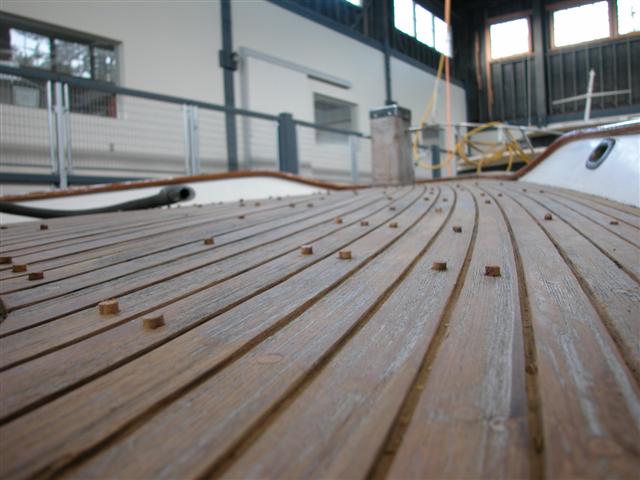
A light sanding brought out a lot of thin bungs. I replaced over 300.
We next used a profile sander and sanded all the grooves. The Fein has a profile attachment but we already owned a Porter Cable profile sander. Once we sanded, it was time to start taping.
The new sealant for the decks is Teak Decking Systems SIS 440. Teak Decking Systems (TDS) advises sanding after application and therefore maintains that taping is not necessary. Since we did not want to sand that much of the old teak decks off, we decided to tape the decks with blue tape.
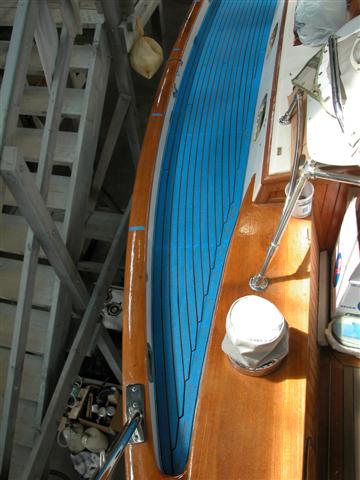
After taping the deck, before the bond breaking tape
They also recommend 'bond-breaking tape' in the bottom of every groove. The bond breaking tape is extremely difficult to apply and I called and talked to them about it, trying to arrive at the conclusion we didn't need to do this. In the end TDS feels the bond breaking tape makes a difference in the water-tightness of the end product. They did indicate that it is more important in hot climates because the deck would expand more; since we were in Seattle we might be able to get by without the bond breaking tape. I was hesitant to do a deck re-caulking that was only applicable to the NW climate so we used it.
TDS recommended using a second roll of tape as a tool to press the tape down or, after emptying a roll, using the plastic core to press the tape down in the bottom of the groove. Worked beautifully.

The light tan color in the bottom of the grooves is the bond breaking tape.
We spent 4-1/2 days taping the decks!
TDS recommended that the tape be pulled immediately since SIS 440 skins over very quickly and would disrupt the bond to the teak once it starts to skin. This required caulking the deck in sections so that the tape could be pulled very soon after application. We divided the deck into sections we could reach across. The fore deck was 4 sections, each side deck contained nine sections. We determined the order in which the sections would be caulked and taped the sections in the reverse order so the tape overlapped correctly for later removal.
Thanks to Andy and Daneen on SV Rose for advising us to make a 'tab' in each piece of tape. It was a lifesaver.
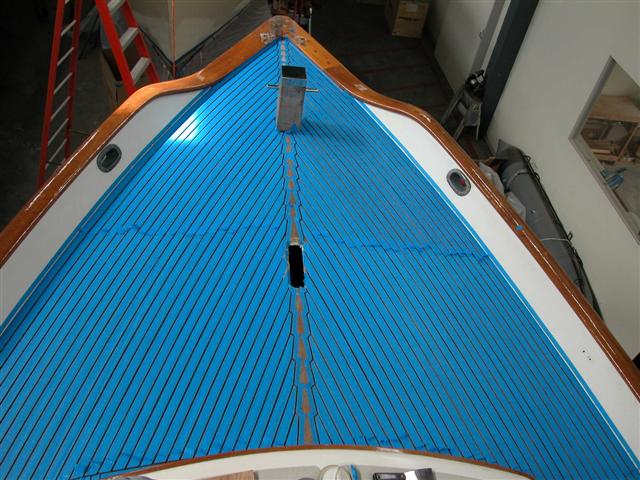
Bow section with tabs.
The bow sections delimited by the tabs in the tape. We decided four sections was enough to keep us from stepping in fresh caulk.

Taping done, ready to start applying TDS....
We bought a Wagner PowerCaulk caulking gun. It was $60 at True Value Hardware, runs off 4 'C' batteries and used three sets of batteries for our whole deck. The variable speed is very nice.
Teresa caulked with the gun, I spooned and pulled tape. We started with two sections on the bow then did the starboard side. On the side decks we alternated between fore and aft sections so we weren't in each other's way.

Two bow sections done, 6 starboard side sections complete.
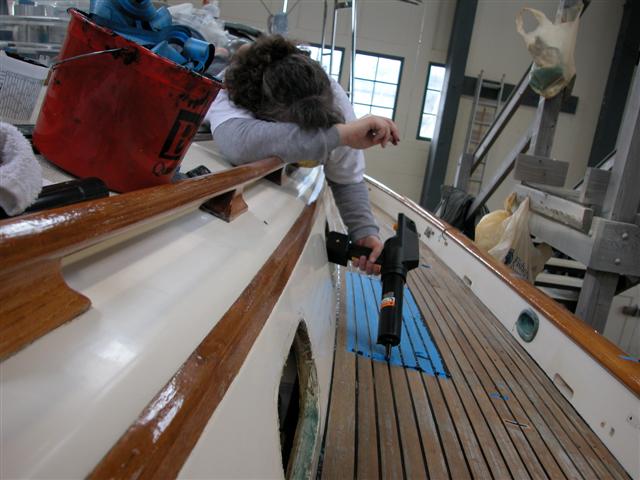
Steady hand with the caulking gun - The last section!!!!
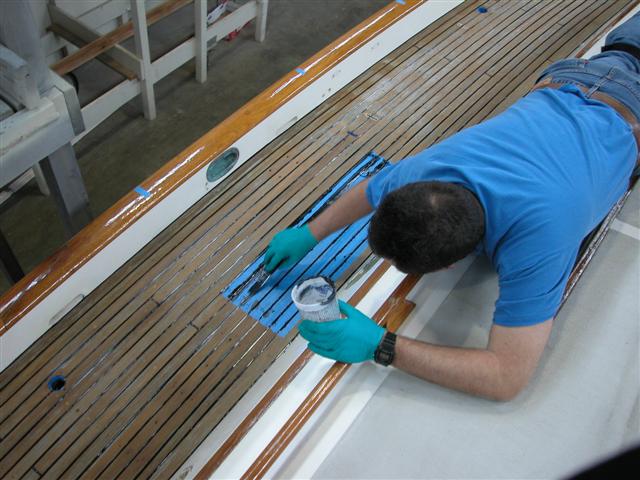
We had to do the last section on each side in smaller pieces to avoid getting black goo all over...
The caulk cured in 24 hours, we spent 3 days total caulking, spooning, pulling tape, and then trying to get the black goo off us, our tools, and the boat. I had a few 'oops' spots while spooning and pulling tape but since SIS 440 is sandable all were easily fixed.This was our first re-caulking job and we are very happy with the results.